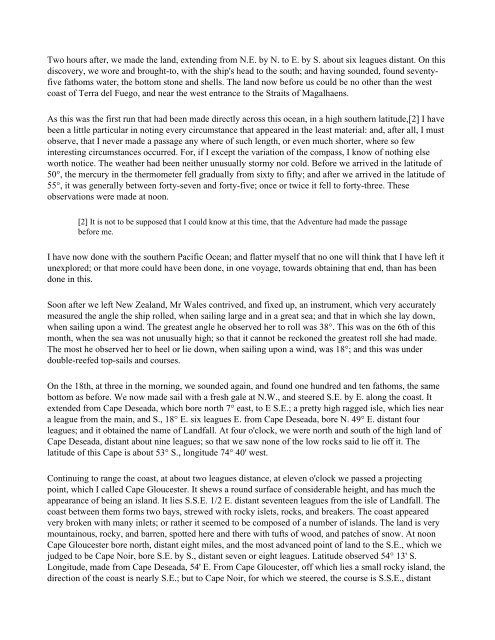A General History & Collection of Voyages and Travels ... - Nauticus
A General History & Collection of Voyages and Travels ... - Nauticus
A General History & Collection of Voyages and Travels ... - Nauticus
You also want an ePaper? Increase the reach of your titles
YUMPU automatically turns print PDFs into web optimized ePapers that Google loves.
Two hours after, we made the l<strong>and</strong>, extending from N.E. by N. to E. by S. about six leagues distant. On thisdiscovery, we wore <strong>and</strong> brought-to, with the ship's head to the south; <strong>and</strong> having sounded, found seventyfivefathoms water, the bottom stone <strong>and</strong> shells. The l<strong>and</strong> now before us could be no other than the westcoast <strong>of</strong> Terra del Fuego, <strong>and</strong> near the west entrance to the Straits <strong>of</strong> Magalhaens.As this was the first run that had been made directly across this ocean, in a high southern latitude,[2] I havebeen a little particular in noting every circumstance that appeared in the least material: <strong>and</strong>, after all, I mustobserve, that I never made a passage any where <strong>of</strong> such length, or even much shorter, where so fewinteresting circumstances occurred. For, if I except the variation <strong>of</strong> the compass, I know <strong>of</strong> nothing elseworth notice. The weather had been neither unusually stormy nor cold. Before we arrived in the latitude <strong>of</strong>50°, the mercury in the thermometer fell gradually from sixty to fifty; <strong>and</strong> after we arrived in the latitude <strong>of</strong>55°, it was generally between forty-seven <strong>and</strong> forty-five; once or twice it fell to forty-three. Theseobservations were made at noon.[2] It is not to be supposed that I could know at this time, that the Adventure had made the passagebefore me.I have now done with the southern Pacific Ocean; <strong>and</strong> flatter myself that no one will think that I have left itunexplored; or that more could have been done, in one voyage, towards obtaining that end, than has beendone in this.Soon after we left New Zeal<strong>and</strong>, Mr Wales contrived, <strong>and</strong> fixed up, an instrument, which very accuratelymeasured the angle the ship rolled, when sailing large <strong>and</strong> in a great sea; <strong>and</strong> that in which she lay down,when sailing upon a wind. The greatest angle he observed her to roll was 38°. This was on the 6th <strong>of</strong> thismonth, when the sea was not unusually high; so that it cannot be reckoned the greatest roll she had made.The most he observed her to heel or lie down, when sailing upon a wind, was 18°; <strong>and</strong> this was underdouble-reefed top-sails <strong>and</strong> courses.On the 18th, at three in the morning, we sounded again, <strong>and</strong> found one hundred <strong>and</strong> ten fathoms, the samebottom as before. We now made sail with a fresh gale at N.W., <strong>and</strong> steered S.E. by E. along the coast. Itextended from Cape Deseada, which bore north 7° east, to E S.E.; a pretty high ragged isle, which lies neara league from the main, <strong>and</strong> S., 18° E. six leagues E. from Cape Deseada, bore N. 49° E. distant fourleagues; <strong>and</strong> it obtained the name <strong>of</strong> L<strong>and</strong>fall. At four o'clock, we were north <strong>and</strong> south <strong>of</strong> the high l<strong>and</strong> <strong>of</strong>Cape Deseada, distant about nine leagues; so that we saw none <strong>of</strong> the low rocks said to lie <strong>of</strong>f it. Thelatitude <strong>of</strong> this Cape is about 53° S., longitude 74° 40' west.Continuing to range the coast, at about two leagues distance, at eleven o'clock we passed a projectingpoint, which I called Cape Gloucester. It shews a round surface <strong>of</strong> considerable height, <strong>and</strong> has much theappearance <strong>of</strong> being an isl<strong>and</strong>. It lies S.S.E. 1/2 E. distant seventeen leagues from the isle <strong>of</strong> L<strong>and</strong>fall. Thecoast between them forms two bays, strewed with rocky islets, rocks, <strong>and</strong> breakers. The coast appearedvery broken with many inlets; or rather it seemed to be composed <strong>of</strong> a number <strong>of</strong> isl<strong>and</strong>s. The l<strong>and</strong> is verymountainous, rocky, <strong>and</strong> barren, spotted here <strong>and</strong> there with tufts <strong>of</strong> wood, <strong>and</strong> patches <strong>of</strong> snow. At noonCape Gloucester bore north, distant eight miles, <strong>and</strong> the most advanced point <strong>of</strong> l<strong>and</strong> to the S.E., which wejudged to be Cape Noir, bore S.E. by S., distant seven or eight leagues. Latitude observed 54° 13' S.Longitude, made from Cape Deseada, 54' E. From Cape Gloucester, <strong>of</strong>f which lies a small rocky isl<strong>and</strong>, thedirection <strong>of</strong> the coast is nearly S.E.; but to Cape Noir, for which we steered, the course is S.S.E., distant


